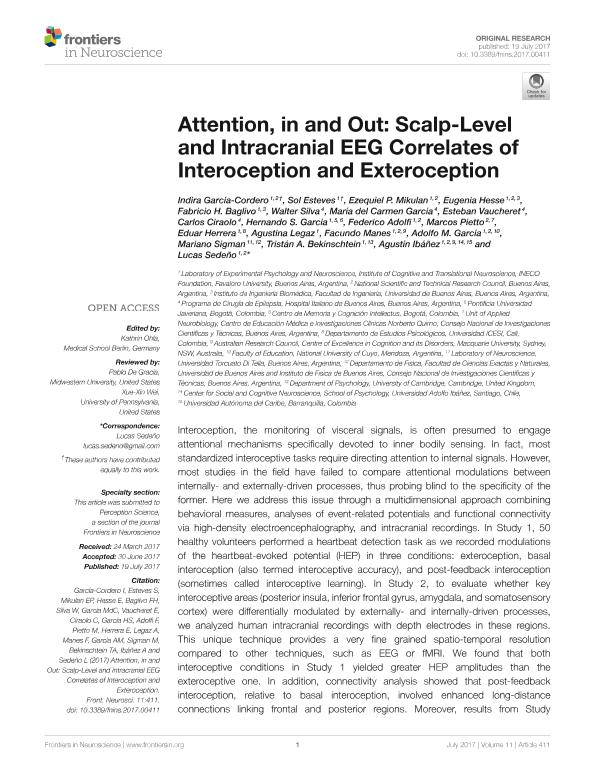Artículo
Attention, in and out: Scalp-level and intracranial EEG correlates of interoception and exteroception
García Cordero, Indira Ruth ; Esteves, Sol; Mikulan, Ezequiel Pablo
; Esteves, Sol; Mikulan, Ezequiel Pablo ; Hesse Rizzi, Eugenia Fátima
; Hesse Rizzi, Eugenia Fátima ; Baglivo, Fabricio H.; Silva, Walter
; Baglivo, Fabricio H.; Silva, Walter ; García, Marìa del Carmen; Vaucheret, Esteban; Ciraolo, Carlos; García, Hernando S.; Gonzalez Adolfi, Federico
; García, Marìa del Carmen; Vaucheret, Esteban; Ciraolo, Carlos; García, Hernando S.; Gonzalez Adolfi, Federico ; Pietto, Marcos Luis
; Pietto, Marcos Luis ; Herrera Murcia, Eduar
; Herrera Murcia, Eduar ; Legaz, Agustina
; Legaz, Agustina ; Manes, Facundo Francisco
; Manes, Facundo Francisco ; García, Adolfo Martín
; García, Adolfo Martín ; Sigman, Mariano
; Sigman, Mariano ; Bekinschtein, Tristán Andrés
; Bekinschtein, Tristán Andrés ; Ibañez, Agustin Mariano
; Ibañez, Agustin Mariano ; Sedeño, Lucas
; Sedeño, Lucas
 ; Esteves, Sol; Mikulan, Ezequiel Pablo
; Esteves, Sol; Mikulan, Ezequiel Pablo ; Hesse Rizzi, Eugenia Fátima
; Hesse Rizzi, Eugenia Fátima ; Baglivo, Fabricio H.; Silva, Walter
; Baglivo, Fabricio H.; Silva, Walter ; García, Marìa del Carmen; Vaucheret, Esteban; Ciraolo, Carlos; García, Hernando S.; Gonzalez Adolfi, Federico
; García, Marìa del Carmen; Vaucheret, Esteban; Ciraolo, Carlos; García, Hernando S.; Gonzalez Adolfi, Federico ; Pietto, Marcos Luis
; Pietto, Marcos Luis ; Herrera Murcia, Eduar
; Herrera Murcia, Eduar ; Legaz, Agustina
; Legaz, Agustina ; Manes, Facundo Francisco
; Manes, Facundo Francisco ; García, Adolfo Martín
; García, Adolfo Martín ; Sigman, Mariano
; Sigman, Mariano ; Bekinschtein, Tristán Andrés
; Bekinschtein, Tristán Andrés ; Ibañez, Agustin Mariano
; Ibañez, Agustin Mariano ; Sedeño, Lucas
; Sedeño, Lucas
Fecha de publicación:
07/2017
Editorial:
Frontiers Research Foundation
Revista:
Frontiers in Neuroscience
ISSN:
1662-453X
Idioma:
Inglés
Tipo de recurso:
Artículo publicado
Clasificación temática:
Resumen
Interoception, the monitoring of visceral signals, is often presumed to engage attentional mechanisms specifically devoted to inner bodily sensing. In fact, most standardized interoceptive tasks require directing attention to internal signals. However, most studies in the field have failed to compare attentional modulations between internally- and externally-driven processes, thus probing blind to the specificity of the former. Here we address this issue through a multidimensional approach combining behavioral measures, analyses of event-related potentials and functional connectivity via high-density electroencephalography, and intracranial recordings. In Study 1, 50 healthy volunteers performed a heartbeat detection task as we recorded modulations of the heartbeat-evoked potential (HEP) in three conditions: exteroception, basal interoception (also termed interoceptive accuracy), and post-feedback interoception (sometimes called interoceptive learning). In Study 2, to evaluate whether key interoceptive areas (posterior insula, inferior frontal gyrus, amygdala, and somatosensory cortex) were differentially modulated by externally- and internally-driven processes, we analyzed human intracranial recordings with depth electrodes in these regions. This unique technique provides a very fine grained spatio-temporal resolution compared to other techniques, such as EEG or fMRI. We found that both interoceptive conditions in Study 1 yielded greater HEP amplitudes than the exteroceptive one. In addition, connectivity analysis showed that post-feedback interoception, relative to basal interoception, involved enhanced long-distance connections linking frontal and posterior regions. Moreover, results from Study 2 showed a differentiation between oscillations during basal interoception (broadband: 35-110 Hz) and exteroception (1-35 Hz) in the insula, the amygdala, the somatosensory cortex, and the inferior frontal gyrus. In sum, this work provides convergent evidence for the specificity and dynamics of attentional mechanisms involved in interoception.
Archivos asociados
Licencia
Identificadores
Colecciones
Articulos(CEMIC-CONICET)
Articulos de CENTRO DE EDUCACION MEDICA E INVESTIGACIONES CLINICAS "NORBERTO QUIRNO"
Articulos de CENTRO DE EDUCACION MEDICA E INVESTIGACIONES CLINICAS "NORBERTO QUIRNO"
Articulos(OCA HOUSSAY)
Articulos de OFICINA DE COORDINACION ADMINISTRATIVA HOUSSAY
Articulos de OFICINA DE COORDINACION ADMINISTRATIVA HOUSSAY
Citación
García Cordero, Indira Ruth; Esteves, Sol; Mikulan, Ezequiel Pablo; Hesse Rizzi, Eugenia Fátima; Baglivo, Fabricio H.; et al.; Attention, in and out: Scalp-level and intracranial EEG correlates of interoception and exteroception; Frontiers Research Foundation; Frontiers in Neuroscience; 11; 411; 7-2017; 1-14
Compartir
Altmétricas



